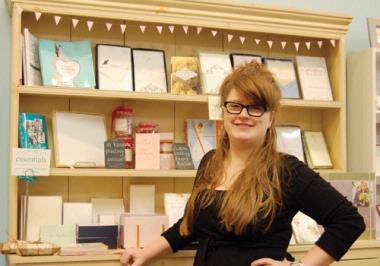These days we can do or get almost anything online. Colette Katsikas, owner of the Northampton store Essentials, notes that with some things-wedding invitations, in this case-the visual and the tactile still count. “People feel a need to see the options with their own eyes, the real thing, not just an image on the screen,” she says. As fewer service outlets for things like printing remain in business, it turns out that her wedding and party invitation operation is relatively rare. Customers from Palmer and Springfield, not only Northampton and its neighboring towns, seek out her services.
“Many people walk in almost wide-eyed-not quite deer in the headlights, but a little disoriented,” she notes. “To plan a wedding can be a rather involved process. It’s not the kind of thing most people have practiced beforehand. So there you are, recently engaged-and suddenly you face a lot of decisions that seem to come all at once. Weddings can be a big deal. Marriage is certainly a huge commitment. The planning process deserves respect.”
Katsikas believes that her first order of business is to put people at ease. Then she wants to understand what they have in mind for invitations. She says, “Some people have very clear ideas about the invitation’s look or feel, and their budgets. More people come in bewildered.” She asks about the wedding itself. “The wedding plans can offer clues about the invitation,” she explains. “A really traditional wedding more often calls for a very traditional invitation. On the other hand, a very nontraditional wedding invites more flexibility for the invitation’s style and feel. What people care about dictates their choices, too. One couple came in whose wedding was all about the food they served. They decided to stick to that theme for the invitations. Their invitation read like a menu, the RSVP card was a reservation card, and on like that. The invitation offered guests a preview, too.”
Among Essentials’ clientele are same-sex couples or slightly older couples planning first or second weddings. Less traditional couples often rely less upon convention for their weddings. A more traditional route tends to be the one taken by younger clients. “Many younger brides come in with their mothers,” Katsikas observes. “Those brides are balancing their dreams and their mothers’ dreams, too. They are often intent about how to do things correctly.”
Among the things people come in unschooled about is the customary timeline for sending out invitations. “Work backwards,” Katsikas advises. “You want to send the actual invitations out between six and eight weeks before the wedding. Ahead of that, you need to allow six weeks for the invitations to be printed and some time-maybe a few weeks or even a month-to address the invitations. Long before you mail invitations, though, you’re likely to send Save the Date cards. Many people do so six months to a year beforehand, especially if they’re having a destination wedding that will require people to book flights, or if their wedding falls on a big holiday weekend, which may necessitate some extra planning for guests.”
How far in advance of their weddings do the majority of couples first arrive at her store to explore invitation possibilities? Katsikas says people tend to come in a year or more ahead of their big day. “The average wedding tends to have about 100 or 125 guests. There aren’t that many places to accommodate large parties around here. Most venues are booked at least a year in advance. So, once you have your location, you realize there are other things that require advance planning. By the time people come to me, they are locking in catering and photographers and music. You find yourself edging into wedding mode and it seems like you may as well dive in.”
Customers can peruse albums filled with sample wedding invitations at a long table in the back of the store. Examples help them to narrow their preferences. The store offers designs through twenty companies. When navigating these options, Katsikas’ knowledge about what each company offers ensures that she can suggest the widest array of selections possible.
Some people want even more customization. Katsikas has a printer for in-store invitation design and production. She says, “I can print invitations, and for that matter, I can assemble the entire package-reply cards and information cards, whatever couples choose-and address the envelopes. This comes in especially handy for small events-maybe a bridal shower-and for things you create in addition to the invitations themselves, things you want to turn around quickly, like a printed menu or a program for the ceremony or place cards.” About a quarter of her customers opt for in-store printing-and often add those auxiliary services.
The range of customers swings not only from very traditional to nontraditional, but from wanting little to do with crafting invitations to being very hands-on. “I tell people I can get them halfway to homemade,” Katsikas says. Given her own craftiness and her sources for materials, including papers and ribbons, she’s able to create invitation packages that look as if the couple did the invitations themselves, or provide the raw materials so that they can actually do so. Constantly on the lookout for ideas, Katsikas maintains an active presence on Pinterest, including many wedding-related boards.
Interestingly, the litmus test for whether the wedding business would be a savvy direction for the store-which specializes in stationery, home goods and gift merchandise-wasn’t wedding-related; it was furniture. Although there’s little furniture in stock, catalogues and swatches suffice, and Katsikas says she learned that if you walk someone through the process, have enough to see and feel to give a good idea of what the product will be like and know enough about the merchandise, you prove a very capable guide. As for wedding preparations, “You’re working with people and you’re helping them through a set of very personal decisions,” she reflects. “The process really counts.”



